
Plumbing Nightmares & Repair Horror Stories
You might expect ghosts and ghouls from horror stories, right? But a different kind of nightmare scares many adults — and it’s not haunted houses.

You might expect ghosts and ghouls from horror stories, right? But a different kind of nightmare scares many adults — and it’s not haunted houses.
You might expect ghosts and ghouls from horror stories, right?
Did you know an estimated 76 million homes in the
Your garbage disposal is a handy appliance in the kitchen,
Your toilet is, unfortunately, not a magical portal to another
*Limit one coupon per household/property. Coupons/discounts cannot be combined with any other offers. Restrictions may apply.
Legacy Plumbing HQ
1101 E Eldorado Pkwy
Little Elm, TX 75068
469-389-4020
Legacy Plumbing Frisco
15222 King Road, STE 1002
Frisco, TX 75034
972-752-6537
8:00 AM to 5:30 PM
Monday – Friday
Legacy Plumbing HQ
1101 E Eldorado Pkwy
Little Elm, TX 75068
(972) 357-1754
Legacy Plumbing Frisco
15222 King Road, STE 1002
Frisco, TX 75034
(972) 449-5879
7:00 AM to 5:30 PM
Monday – Friday
Drain cleaning and clog clearing technology has advanced a lot past the simple drain snake!
Now, plumbers have other specialty drain tools like hydro jetters and flex-shaft machines. But are these newer technologies better? If so, what are the specific advantages that they give? When should each be used?
In this article, we’ll discuss the different technologies for cleaning drain pipes so that you can decide what is best for your home and your situation.
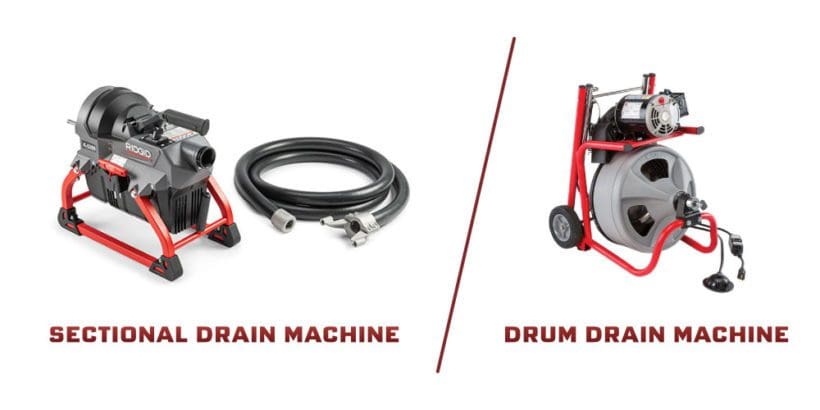
Traditional drain snake machines are pretty simple in design. A large, powerful motor turns a coiled steel cable that is fed into the drain pipe. This cable can have many different heads attached to it. These heads clear pipe obstructions as they rotate with a great degree of force.
These machines usually fall into two different categories: drum machines and sectional machines. The drum machines use one long, continuous cable in a large coil that rotates. Sectional machines use shorter cables that link together to be as short or as long as needed. These smaller cables are stored in a coil and disconnected/fed into the machine as needed.
A lot can be done with one of these traditional snake machines and a simple auger bit. Most stoppages can be broken up and washed down the drain by a skilled operator. Additionally, they create spade-shaped cutter bits and “C” shaped cutter heads. These are often used to move a larger amount of mass such as a significant toilet-tissue buildup or grease buildup. In situations where there are a lot of roots intruding into the pipe, they have saw-tooth or shark-tooth cutter bits that can grind away at these clogs and wash them down the drain.
Drain snakes have always been the go-to for unclogging stopped-up drain lines. They are very effective at doing everything from clearing roots to retrieving stuck objects. With the correct machine in the hands of an experienced drain technician, there is no more versatile or powerful drain cleaning tool.
Drain specialist plumbers usually develop their own set of preferred tools/bits/techniques. They know their equipment so well that they can literally “feel” what the cable goes through without seeing it. They often know if the cable is turning through a fitting or running up against a stoppage. They can sometimes even tell what the characteristics of that stoppage are!
Although these drain machines will probably remain the industry standard for plumbers, there are some weaknesses in this design that have prompted plumbers to look for additional tools and solutions.
One of the major limitations of drain snakes is that they aren’t very efficient at clearing all of the scale buildup on the sides of old cast-iron pipes. If the pipe isn’t so badly damaged as to render it unsalvageable, then a drain snake can usually clear an obstruction and get the pipe draining again. However, the insides of the pipes will usually remain rough from years of rusty scale buildup. We tend to see this more often in older neighborhoods built closer to Dallas like those in much of Plano and Carrollton.
Another limitation of these machines is that they can get stuck more easily if used incorrectly. If a smaller cable size is used in too large of a pipe, the cable can twist and knot itself up. It is very difficult to remove at that point. If the pipe is damaged, some of the bits used with drain snakes can get caught on the broken edges and be tricky to free.
Finally, if there is an especially heavy grease buildup (or the buildup of another substance like sand, dirt, sludge, etc) it can be very time-consuming to wash all of this debris down the drain with a traditional snake and the gravity flow of water in the pipe.
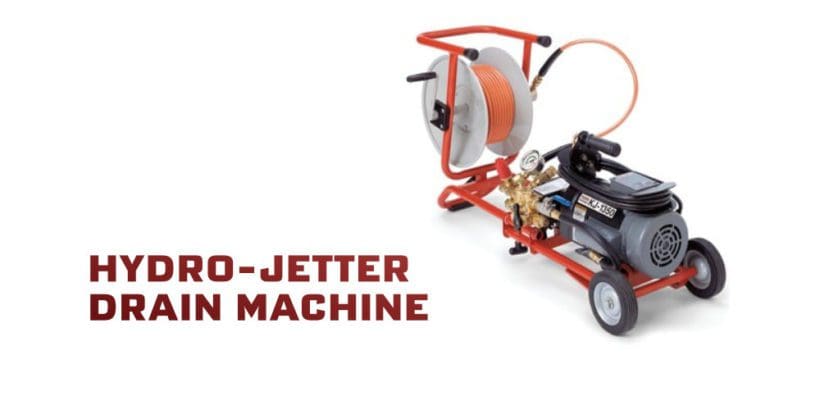
Hydro-jetters were a technological innovation that gained widespread popularity due to their ability to overcome some of these challenges. They use highly pressurized water (usually between 1200 and 3000 psi) to blast away pipe obstructions, scour the insides of the pipes, and self-propel the hose down the drain.
There are both gas-powered hydro jetters and smaller, electric versions as well. They usually cost quite a bit more than drain snakes due to the added complexity of the equipment. Another important rating is the GPM (gallons-per-minute). These machines usually range from 1 ½ to 5 gallons per minute – which affects how quickly they can move sludge buildups.
The machine cables have different styles of heads as well, but most are a combination of forward-facing and rear-facing jets. These serve to both clean the pipe and propel the jetter down the pipe at the same time.
Hydro jetters are very versatile machines with some models able to clear sewer pipes from 2″ to 10″ in diameter. As already mentioned, because water is used as the scouring tool, it also serves to flush the debris down the pipes at the same time. This is very important if you’re dealing with a lot of material in the drain line that needs to be removed.
However, it’s not a magic bullet. When it comes to busting free heavy-duty clogs, the hydro jetter doesn’t have the same power as a properly-sized traditional drain snake. It also cannot retrieve objects out of the drain as some drain snake tools can. While it often does a better job at cleaning scale and grease buildup, it still falls a little short of clearing heavy rust buildup that is clinging to the sides of the pipe.
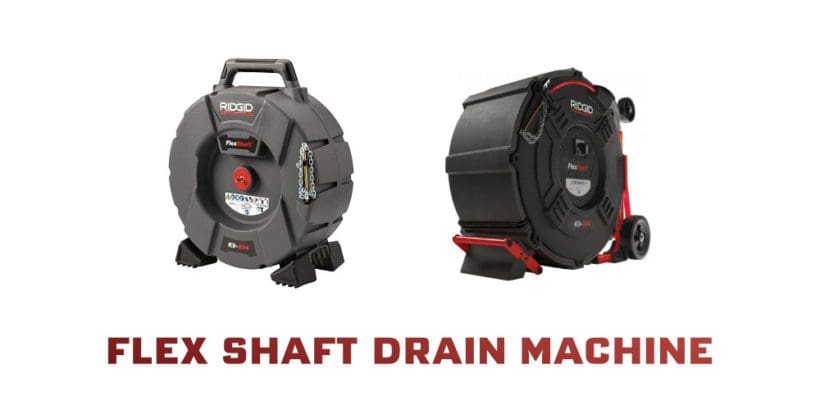
The newest drain innovation to help with descaling old sewer lines are high-speed flex-shaft machines. These are often called chain knockers or flexi-rooter machines. They operate by spinning a flexible core cable at very high speeds through a stationary outer sheath which gets fed down the sewer pipe. Different heads can be attached to the end, but the most commonly used are called “chain knockers” which flare out and scrape the sides of the pipe as they spin.
While they weren’t readily available a few years ago, you can now purchase versions of these machines from a handful of the major manufacturers of drain cleaning equipment like Ridgid, General Pipe Cleaners, and Spartan Tool.
The length of the cables usually ranges from around 50 feet to over 100 feet. Although less versatile than the water jetting machines, you can readily buy different versions that will clean pipes from 1 ¼” to 6″.
The one thing that stands out about flex shaft machines is how fast they spin. They are commonly able to spin at over 2000 rpm! This opens up a new level of effectiveness at scraping and cleaning the sides of pipes with significant scale and rust buildup. As the head of the flex shaft machine spins super fast, “centrifugal” force causes carbide-tipped chains to flare out to a pre-adjusted size and drag against the pipe walls.
Although they are sometimes used to clear clogged pipes, that’s not where these flex shaft machines shine. They may not be able to clean especially heavy clogs because they have less torque power. In practical usage, the stoppages/clogs are often cleared first with a traditional drain snake. Then, if a camera inspection reveals a significant build-up on the sidewalls of the pipe, it may be decided to follow up with the flex shaft machine.
One particular advantage to the flex shaft machine is that it can be running with a sewer inspection camera in the pipe at the same time. This allows very fine control over the cleaning process.
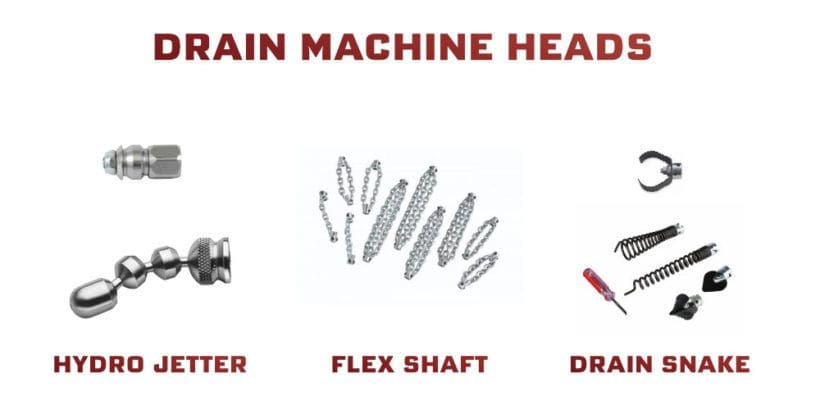
This ultimately depends on your comfortability with tools and DIY projects. Many minor fixture clogs don’t require expensive equipment to clear. If water backs up fairly quickly when you turn on the faucet and no other fixtures seem to be affected, there is likely a stoppage in the P-trap or the drain stopper assembly of the fixture.
Sometimes, these can be cleaned with a tool like the Zip-it. Sometimes, the clog can be cleared by disassembling the slip joint pipes and manually cleaning it out. (Warning: this can get messy!) Other times, these types of clogs can be cleared with a small, hand-held drain snake that you can purchase at the home improvement store. (These snakes usually only extend up to 25 feet, and they are generally only effective in smaller pipes.)
If it is a toilet that is clogged up, you’ll need a special tool called a “toilet auger” or “closet auger”. These can be purchased at the home center as well, but they are only effective if the clog is in the toilet itself or directly passed it. Even the professional grade ones cannot extend more than 6 feet.
If this doesn’t work, if multiple fixtures are backing up, or if the faucet runs for a while before the water starts to back up, then the clog will probably need to be cleared by one of the larger machines listed above. This is usually quite a bit beyond the scope of what the average homeowner is comfortable with!
While an experienced plumber can often make clearing a clog look like an easy task, there is a lot that can go wrong without the right tools (and the experience to go along with it).
What is the best access point or cleanout? What if there isn’t a cleanout? What if the pipe is broken and the cable gets stuck? Construction practices and home characteristics vary widely across the DFW metroplex. The homes that were built in the early 2000s in Frisco are laid out differently than those built in the 1970s in Plano. So much time can be saved by the experienced plumber who knows right where to look and where to start!
At Legacy Plumbing, every truck is equipped with a variety of drain cleaning tools as well as video camera inspection equipment. This means we can fix it right the first time with minimal disruption to your day-to-day routine. If there is a more significant issue like a broken pipe or excessive scale buildup, we can pinpoint the issue on camera and talk all about the different options for repair.
To find out pricing and schedule availability, give us a call today at (972) 632-5412
* Images of sewer equipment in this blog article are from Ridgid.com
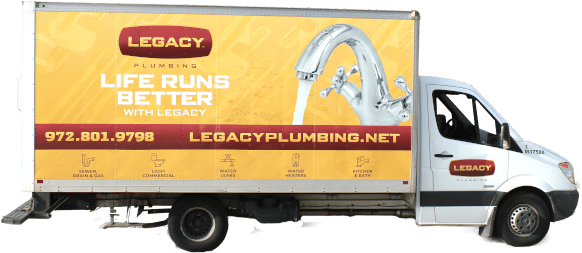
If you found this helpful, please take a minute to share it on social media. Also, feel free to pass this content along to friends/family/clients of yours who may find this helpful.
Headquarters
1101 E Eldorado Pkwy
Little Elm, TX 75068
Legacy Plumbing Frisco
15222 King Road, STE 1002
Frisco, TX 75034
7:00 AM to 5:30 PM
Monday – Friday
Check out all of our Ace Hardware Home Services locations at:
Home Maintenance Services & Repair | Ace Hardware Home Services